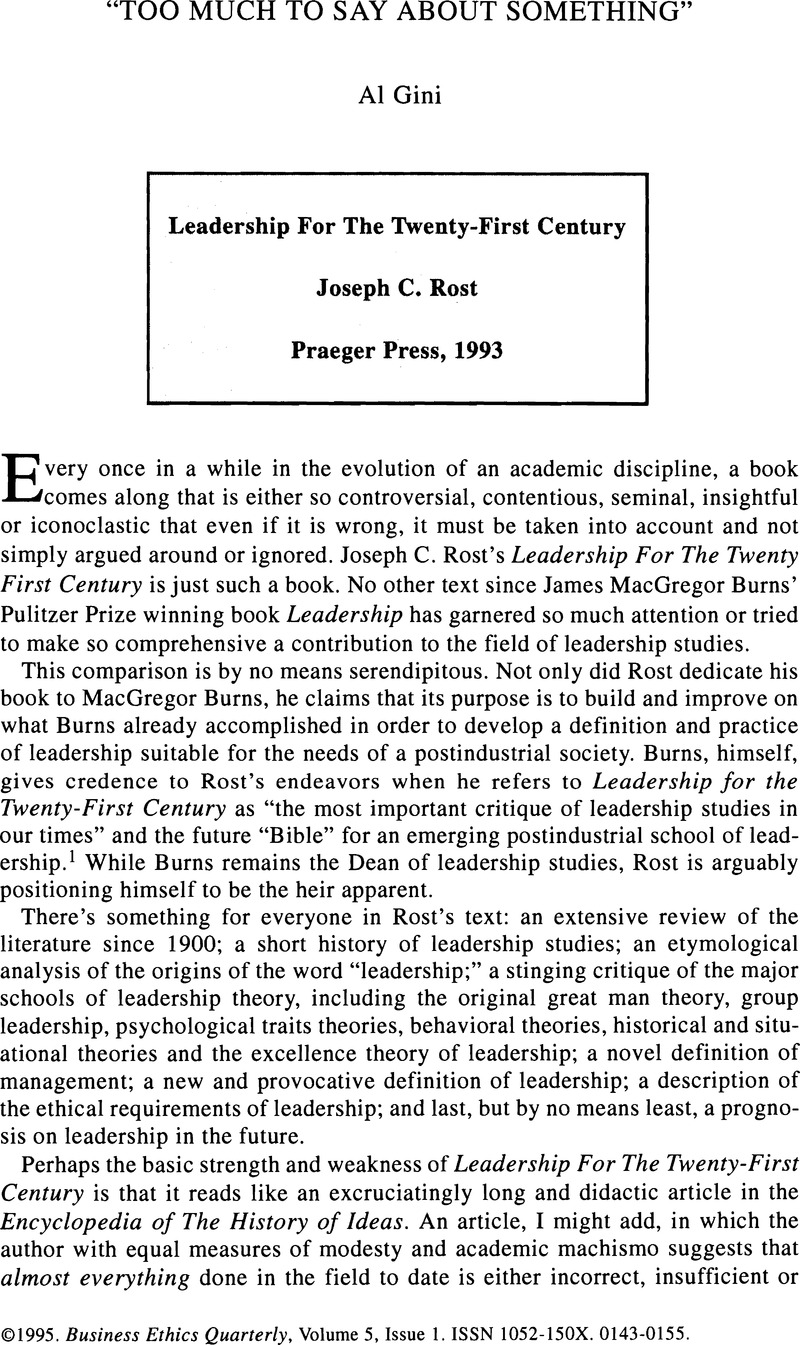Published online by Cambridge University Press: 23 January 2015

1 J. C. Rost, Leadership for the Twenty-First Century, Westport, CT: Praeger, 1993, Foreword, p. xii.
2 Ibid., p. 179.
3 Ibid., p. 5.
4 Ibid., p. 19.
5 Ibid., p. 69.
6 Ibid., pp. 45, 46, 47.
7 Ibid., p. 179.
8 Ibid., p. 92.
9 Ibid., p. 93.
10 Ibid., p. 94.
11 Ibid., p. 180.
12 Ibid., p. 120.
13 Ibid., p. 181.
14 Ibid., p. 102.
15 James MacGregor Burns, Leadership, New York: Harper Torchbooks, 1979, p. 12.
16 Rost, Leadership For The Twenty-First Century, p. 43.
17 In a recent article Rost has made a change in his use of the word “followers.”
I now use the word followers when I write about leadership in the industrial paradigm. I use the word collaborators when I write about leadership in the postindustrial paradigm. This is a change from—Leadership in The Twenty-First Century—in which I use the word followers all the time. The reason for the change is the unanimous feedback I received from numerous professionals throughout the nation… After trying several alternative words, I settled on the word collaborators because it seemed to have the right denotative and connotative meanings. In other words, collaborators as a concept fits the language and values of the postindustrial paradigm and so its usage should not be a problem to those who want to articulate a new paradigm of leadership.
J. E. Rost, “Leadership Development In the New Millennium,” The Journal of Leadership Studies, 1993, V. 1. N.l, pp. 109, 110.
18 Rost, Leadership For the Twenty-First Century, p. 61.
19 Ibid., p. 109.
20 J. W. Gardner, On Leadership, New York: The Free Press, 1990. p. 6.
21 Burns, Leadership, p. 426.
22 Rost, Leadership in the Twenty-First Century, p. 123.
23 Ibid., p. 116.
24 A. Zaleznik, “The Leadership Gap,” Academy of Management Executive, 1990, V.4, N.1, p. 12.
25 Rost, Leadership In the Twenty-First Century, p. 124.
26 Ibid., p. 1.
27 Ibid., p. 182.
28 W. G. Bennis, NPR—Marketplace, USC Radio, Sept. 7, 1992.
29 Rost, Leadership In the Twenty-First Century, p. 145.
30 A. Zaleznik, “The Leadership Gap,” p. 14.
31 Rost, Leadership In the Twenty-First Century, pp. 140–141.
32 Ibid., p. 64.
33 W. G. Bennis, On Becoming a Leader, Reading, MA: Addison-Wesley, 1989, p. 89.
34 G. Sheehy, Character: America’s Search For Leadership, New York: Bantam Books, 1990, p. 311.
35 Ibid., p. 66.
36 Rost, “Leadership Development In the New Millennium,” p. 99.
37 Rost, Leadership For The Twenty-First Century, p. 166.
38 Ibid., p. 154.
39 Ibid., p. 152.
40 Ibid., p. 161.
41 Ibid., pp. 156–160.
42 Ibid., p. 153.
43 Ibid., p. 175.
44 Ibid., p. 176.
45 Ibid., p. 163.
46 Ibid., Foreward, p. xi.